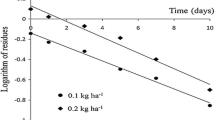Abstract
Dissipation behaviour of endosulfan and dichlorvos in/on cauliflower, variety Snowball-16, was studied during rabi season (Sep.–March) 2003–2004. Endosulfan and dichlorvos were sprayed @ 350 and 110g a.i. with 115 g a.i., respectively, 80 days after transplanting. Samples were taken at the interval of 0 (1h after spray), 3, 5, 7, and 10 days after spray (DAS) in triplicate and residues were estimated on GC-ECD system equipped with capillary column. The initial deposits of 3.452 and 0.295μgg−1 of endosulfan and dichlorvos dissipated to 0.084 (97.56%) and 0.009 (96.95%), respectively after 10 DAS. Residues of endosulfan reached below maximum residue limit of 2μgg−1 one day after spray and of dichlorvos were below MRL value of 0.5μgg−1 even on 0 day. Dissipation pattern followed first order kinetics for both the insecticides with half life periods of 1.81 and 2.08 days for endosulfan and dichlorvos, respectively.
Similar content being viewed by others
References
Agnihotri, N. P.: 1999, ‘Pesticide Safety Evaluation and Monitoring’ Edited by All India Coordinated Research Project on Pesticide Residues. Division of Agricultural Chemicals, Indian Agricultural Research Institute, New Delhi. pp. 132–142.
Anonymous: 2002, ‘Package Practices for Vegetable and Horticultural Crops’, CCS Haryana Agricultural University Hisar.
Bordia, J. S. and Gupta, H. C. L.: 1992, ‘Residues of monocrotophos carbaryl, fenitrothion in cauliflower’, Indian J. Ent. 54, 230–232.
Dinabandhoo, C. L. and Sharma, I. D.: 1994, ‘Efect of decontamination process on insecticide residues on cauliflower’, Indian J. Pl. Prot. 22(1): 77–82.
Jaglan, R. S. and Yadav, P. R.: 1986, ‘Persistence and degradation of endosulfan in and on unprocessed and processed cauliflower curds’, Indian J. Ent. 48(4), 441–447.
Kalra, V. K. and Sharma, S. S.: 2000, ‘Comparative efficacy of thiodicarb and some other newly introduced insecticides against Plutella xylostella (L.)’, Haryana J. Hort. Sci. 29(1/2), 134–135.
Kanvar, B. S.: 1990, Himachal Pradesh Agricultural Handbook, pp. 188, Himachal Pradesh Krishi Vishva Vidyalaya, Palampur.
Kathpal, T. S. and Dewan, R. S.: 1975, ‘An improved clean up technique for the estimation of residues of endosulfan and endrin’, J. Assoc. Anal. Chem. 58, 1076–1078.
Kavadia, V. S., Noor, A. and Saxena, R. C.: 1974, ‘Residues and persistence of endosulfan (Thiodan) in the head and leaves of cauliflower’, J. Fd. Sci. Tech. 11, 63–65.
Khan, M. A. M., Reddy, D. J. and Rao, S. V.: 1999, ‘Dissipation of dichlorvos and dimethoate residues in okra’, Pestic. Res. J. 11(2), 204–206.
Krishnaiah, K. and Mohan, N. J.: 1983, ‘Control of cabbage pests by new insecticides’, Indian J. Ent. 45, 222–228.
Kumari, Beena, Kumar, R. and Kathpal, T. S.: 2001, ‘An improved multiresidue procedure for determination of 30 pesticides in vegetables’,Pestic. Res. J.(1), 32–35.
Lal, O. P.: 1990, ‘Evaluation of control of schedule against insect pests of cabbage seed crop in Kulu valley, India’, Revista di Agicoltura Sub Tropicale 84, 249–263.
Malathi, S., Sriramalu, M. and Rameshbabu, T.: 1999, ‘Dissipation of endosulfan in cabbage, Brassica oleracea Var. capitat’, Pestic. Res. J.(2), 215–217.
Singh, B., Chahal, K. K. and Singh, P. P.: 1993, ‘Dissipation of endosulfan on cauliflower (Brassica oleracea var. botrytis subvar cauliflora)’,Indian J. Agric. Sci.(10), 668–671.
Srinivastava, A. S. and Srinivastava, J. L.: 1972, ‘Ecological studies on the aphid, painted bug and saw fly affecting mustard and rape in India’,F.A.O. Prot. Bull.(6), 136–140.
Verma, S. and Lal, R.: 1976, ‘Residues and residual toxicity of endosulfan on cauliflower’, Indian J. Agric. Sci. 46, 125–129.
Author information
Authors and Affiliations
Corresponding author
Rights and permissions
About this article
Cite this article
Deivendran, A., Kumari, B. & Yadav, G.S. Dissipation of Endosulfan and Dichlorvos Residues In/On Cauliflower Curds. Environ Monit Assess 116, 307–313 (2006). https://doi.org/10.1007/s10661-006-7394-y
Received:
Accepted:
Issue Date:
DOI: https://doi.org/10.1007/s10661-006-7394-y




